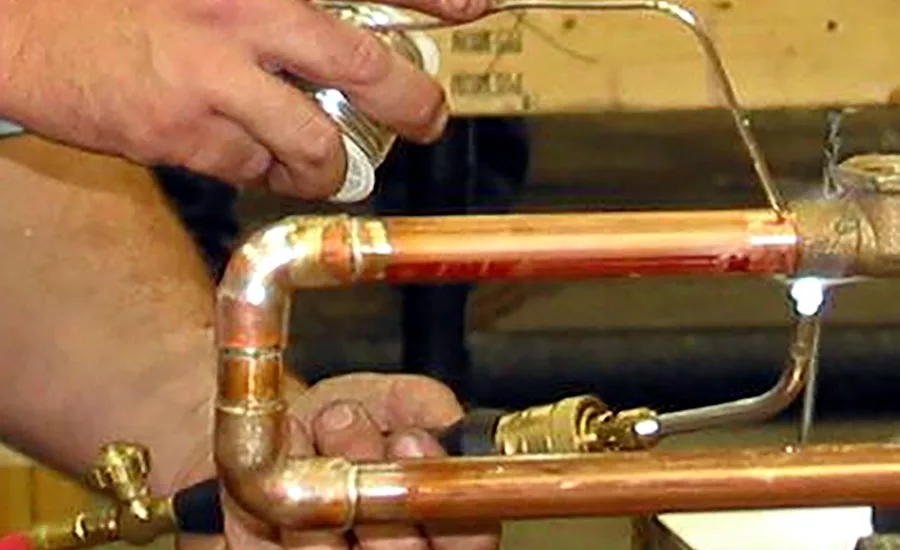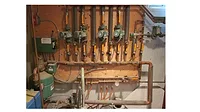Solder & Flux: Avoid these common pitfalls when sweating a copper joint

Any good training program will have a repetitive component to it. Major league ballplayers, for example, still do the same pre-game infield and outfield drills prior to each and every game and who knows how many times during the day beforehand. Why? These are big-league ballplayers. Certainly they’re beyond forever fielding ground balls and, “getting two.” It’s actually the repetition that keeps them sharp. Watch a player that’s been out of the lineup, even for a couple of games, and you’ll see somebody who’s going to need a little time to get back in the groove.
It’s the same thing with plumbing. Everyone in the business who has spent any time as a tech has spent countless hours sweating copper joints. Here, from start to finish, are a few ways to ensure you get good results when sweating a pipe joint. (NOTE: We would hope it goes without saying to always use “lead-free” solders and fluxes when dealing with systems that carry potable water. Well, you’d think it would. But here we are saying it. So it goes.–Ed]
1. Cut the material square.
The best way to ensure this happens is to use the proper tool – a pipe cutter. The reason? Pipe ends slide into various couplings. Many times they’ll bottom out on a ridge inside the coupling to make sure the pipe is seated at the proper depth. If that cut is angled, only a tiny part of the cut lines up, and that’s going to make getting a good solder joint difficult.
2. Clean and de-burr the pipe.
Use some emery cloth on the end of the pipe to be sweated to clean off all the oxidation and/or protective coatings and leave a clean, bright, roughed-up surface that will let the solder really take hold. This goes for both the inside and outside of a joint, so don’t be shy about getting inside the coupling and giving it a good scrub, too. Both surfaces need to be prepped.
Most quality pipe-cutters will have a deburring tool as an integral part of its construction. Take care to leave the cut end of the pipe you’re working with as clean, round and free of sharp edges as you can before even thinking about…
3. Applying the right amount of flux.
An article in this magazine not long ago made the critical error of lightheartedly referring to the application of flux to a joint to be soldered as a, “slathering.” No. “Slathering” is the last thing in this lifetime you want to do with flux. A light, thin, even coat of flux that is applied with a brush (and not your fingers) and that is not at all like a “slathering” is what you want. Flux properly applied will assist the solder in penetrating the joint evenly and making the kind of joint you’ll want to Instagram.
4. Heat the joint.
Now that you have your clean, evenly cut, deburred pipe lightly coated with flux and properly seated into the coupling it’s time to get serious. Use the blue tip of your torch’s flame to evenly heat the joint. Then hold the flame on one side of the joint and your solder on the other. Don’t use the flame from the torch to melt the solder – let the hot metal on the joint melt it instead. Soon enough it will begin to be drawn into the joint. Keep going until the seam in the joint looks “full” all the way around but don’t overfill. A handy rule-of-thumb we heard somewhere says to match the length of solder you use on a sweated joint to the diameter of the pipe – a half-inch of solder to do a joint in half-inch pipe, ¾-inches for ¾”-inch pipe and so on. Your mileage, however, may vary.
5. Wipe it off.
Give the newly sweated joint a few minutes to cool down. And always take the time to use a damp rag or sponge to thoroughly clean off any excess flux that may have seeped out of the joint. Otherwise that nice, shiny joint you just created will end up covered in ugly green corrosion almost right away. Copper mechanical rooms with every sweated joint covered in nasty green flux residue don’t instill confidence in your customers or get photographed for magazines.
And there you have ‘em. Five big tips aimed at getting you the most bang from your pipe sweating buck. Just keeping these few little tips in mind the next time you need to build with fire will go a long way to ensuring your plumbing career winds up with you fat, happy, retired and on a golf course.
"This article was originally posted on ww.reevesjournal.com."
Looking for a reprint of this article?
From high-res PDFs to custom plaques, order your copy today!







